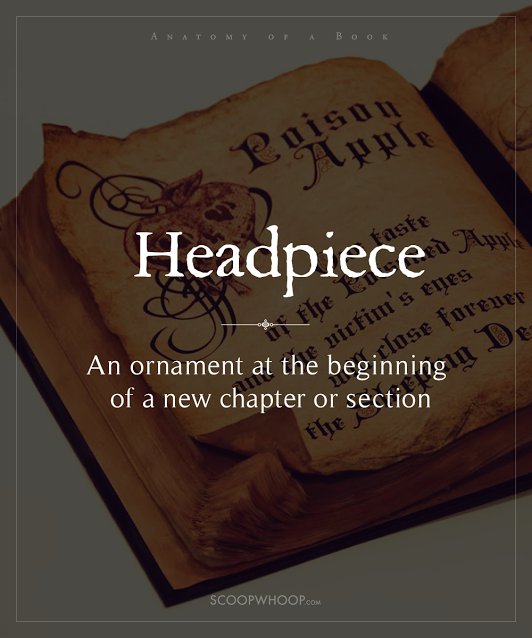They are not mere pages being held together, they are man’s primary and most important source of knowledge. Books have been at the receiving end of a tremendous amount of love, not just for what they contain but because they hold the power to stay with you, physically or otherwise. And like all things that are loved, books have been named and they have been named thoroughly, with each part getting the attention it needed. But do you know your books well?
We have enlisted, for you, terms you’d want to keep in mind, because if you love something you want to know it inside out, right?
1. Leaves
Please do not be confused. We are not talking about trees and leaves, or the colour green. Leaves are the pages of a book. So yeah, this can sound real fancy when you say, “Turn the leaves of the text to chapter 32, The Elder Wand.” (Someday.)

2. Endpaper
Ever opened a hardback book and tried to decipher the image that follows the moment you open it? Endpapers are the papers stuck to the inside cover of a hardbound book. The side glued to the book is a paste-down, whereas the other side is called the free endpaper.

3. Edges
These are just the edges of the pages or leaves of a book. A very boring term in itself, but full of possibilities for those with an imagination, like all things to do with books. It opens the room for possibilities like gilt edges and painted fore-edges. Ever noticed designs at the opening, when the pages are set together?

4. Wire Lines and Chain Lines
In earlier days, it was a practice to lay wet paper pulp on a frame with criss-crossed wires and shake the water out of it. The wide spaced lines are called wire lines, and the ones perpendicular to these are called chain lines. The quality can now only be seen in expensive high-end stationary, hold that paper against the light and you’ll know what I am talking about.

5. Signatures
When books are assembled, pages are divided into groups of sixteen as per their chronological order. These sets are called signatures. It’s said that there used to be a small notation at the end of each set, helping the bookbinder keep track, which is where the term ‘signature’ comes from.

6. Manuscript
In the book-collecting and historical circles, a manuscript stands for a text that’s written by hand and not printed.

7. Headpiece
This mostly serves an ornamental purpose. Usually denoting a theme, or a leading theme in a text, a head-piece is a symbol or image that marks the beginning of a new chapter or a new part of the book.

8. Half-Title
The extra sheet of paper just before the title page is called the half-title. This is also called the bastard title. Never thought that’d be christened too, did you?

9. Foxing
Ever picked up an old book and admired the way the white has faded into yellowish-brown? This discolouration is called foxing and the pages are called foxed.

10. Diaper
Unlike the one tied around a baby’s waist, this one refers to the patterns some bindings create, like the lozenge and diamond patterns we usually see.

11. Dust Jacket
The paper, other than the hardbound cover, that’s wrapped around a book, with its ends fold into the book itself. This was originally made to protect the cover but now holds a lot more significance. Dust jackets are specially designed by artists to create a sub-conscious or conscious impression of the contents.

12. Spine
This is usually the left side of a closed book. It’s here that all the pages of a book meet and it holds the book together. Ever had a librarian say, “Take care of the spine, don’t open the book too wide”, it’s because if you do, the pages will fall off and ruin the book.

13. Back Cover
This might be known to most. The back cover of a book is the part that carries information regarding the book, it’s sales, the bio of the author and sometimes even a short summary of the content.

14. Book Block
This does not exactly come under anatomy of a text, but if you remove the binding, or hold the pages of a book away from the binding, the pages together are called a book block.

15. Front Matter
The forward, the preface, the acknowledgments and all the other things before the book begins is called the front matter of a text. The numbering of these is differerent from the way the pages of the actual text are numbered.

Never knew that every inch would have a name, did you?
Design credits: Suvojyoti Ray

















